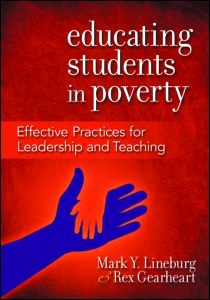Educating Students in Poverty: Practices for Leadership & Teaching
Educating Students in Poverty: Effective Practices for Leadership and Teaching
By Mark Y. Lineburg and Rex Gearheart
(Eye on Education/Routledge, 2013 – Learn more)
With the ever-increasing numbers of families and students living in poverty, schools increasingly need to address concerns related to such students in order to understand their behaviors and assist them in accessing resources, both of which may encourage them to help break the cycle of poverty.
Written for teachers and administrators across the pK-12 public school spectrum, this book conveys the necessity of helping students in poverty succeed in school, graduate from high school, and pursue further education in order to have a chance in gaining worthwhile employment and improving their lives.
Tackling a growing challenge in today’s schools, experienced educators Lineburg and Gearheart present an honest picture of how poverty affects students, families, and the school community at large. They offer a host of practical applications that can be used in every school district in America to meet those challenges head-on! — From the publisher’s book page.
What’s inside

The first chapter begins with addressing the importance of basic fundamentals. It communicates the value of building relationships by treating students and parents with dignity and respect. Providing professional development programs for administrators may help them build the appropriate skills needed to create effective programs, provide leadership in the community and in the school, and help others see the need for change. Visibility and accessibility of staff, safety, stability, cleanliness, high quality teachers, high behavioral expectations: all help contribute to a safe haven for students.
In other chapters, the authors stress the importance of family involvement and communication and the value in encouraging parents to attend student events and develop pride in their children’s school. Communication through phone calls, home visits, and family conferences contributes to a sense of belonging for transient parents and children. Other characteristics of a school that has a strong presence in the lives of students in poverty include:
• a strong preschool program,
• daily routines and expectations,
• encouragement and emphasis on the importance of attendance,
• work with other community service agencies,
• provision of supplemental programs for school and summer,
• consistent routines and discipline strategies,
• clearly stated expectations,
• assistance with good nutrition through school breakfast and lunch programs,
• school and community backpack programs.
A personal note: While education is a central key to improving one’s economic situation, finding lasting solutions to generational poverty is beyond the scope of the public school system and its already over-stressed teachers, administrators and support staff. Schools may be the best place for students to learn and understand how to move into the middle class. But that’s just one piece of the poverty puzzle. Communities, government, families and students themselves all have to be involved and share in the responsibility.
Susan Shaver is a K-12 Library Media Specialist and music teacher in the Hemingford Public Schools, Hemingford, NE.



































